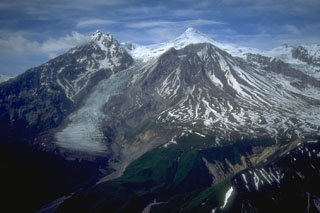Report on Spurr (United States) — 12 March-18 March 2025
Smithsonian Institution / US Geological Survey
Weekly Volcanic Activity Report, 12 March-18 March 2025
Managing Editor: Sally Sennert.
Please cite this report as:
Global Volcanism Program, 2025. Report on Spurr (United States) (Sennert, S, ed.). Weekly Volcanic Activity Report, 12 March-18 March 2025. Smithsonian Institution and US Geological Survey.
Spurr
United States
61.299°N, 152.251°W; summit elev. 3374 m
All times are local (unless otherwise noted)
The Alaska Volcano Observatory (AVO) reported increasing unrest at Spurr in a special information statement issued on 12 March. Collapses of snow and ice into the summit crater lake that formed during the current period of unrest continued to occur along with steam emissions from fumaroles within and around the summit crater. New diffuse steam plumes from small snow-free spots within Crater Peak, a vent 3.5 km S of the summit, were first observed on 6 March. These locations have been sporadically snow-free for years, but steaming had not been observed since 2008. Significantly elevated volcanic gas emissions were measured during overflights on 7 and 11 March, when newly reactivated fumaroles at Crater Peak were also observed. About 450 tons per day (t/d) of sulfur dioxide at the summit crater was measured on 7 March, an increase from less than 50 t/d measured in December 2024. Notably high concentrations of carbon dioxide detected at Crater Peak are similar to values measured before other eruptions such as Redoubt in 2009. An average of 100 earthquakes per week were located during the past month; most were shallow, around 4 km below sea level, with the largest being M 2.7. Over 3,400 earthquakes had been located since April 2024. Ground deformation continued to be detected with a total of about 6.5 cm of inflation recorded at the closest Global Navigation Satellite System (GNSS) station. Modeling of the data suggested that the source was located 3-5 km below sea level and 3-4 km W of the summit. Seismicity remained elevated during 13-18 March with numerous small, shallow volcanic earthquakes detected beneath the volcano. Weather clouds often obscured views, though the crater lake and a gas plume were visible on 15 March, and a small steam plume rising from the summit was observed in clear webcam and satellite images during 17-18 March.
The interpretation from AVO is that a magmatic intrusion has been underway for months, and the recent gas data suggests that a new pathway towards the Crater Peak vent has opened; Crater Peak erupted in 1953 and 1992 and the summit last erupted several thousand years ago. The Volcano Alert Level remained at Advisory (the second lowest level on a four-level scale) and the Aviation Color Code remained at Yellow (the second lowest level on a four-color scale).
Geological Summary. Mount Spurr is the closest volcano to Anchorage, Alaska (130 km W) and just NE of Chakachamna Lake. The summit is a large lava dome at the center of a roughly 5-km-wide amphitheater open to the south formed by a late-Pleistocene or early Holocene debris avalanche and associated pyroclastic flows that destroyed an older edifice. The debris avalanche traveled more than 25 km SE, and the resulting deposit contains blocks as large as 100 m in diameter. Several ice-carved post-collapse cones or lava domes are present. The youngest vent, Crater Peak, formed at the southern end of the amphitheater and has been the source of about 40 identified Holocene tephra layers. Eruptions from Crater Peak in 1953 and 1992 deposited ash in Anchorage.
Source: US Geological Survey Alaska Volcano Observatory (AVO)

